
Russian Russian Museum - the world's largest museum of Russian art, located in the city of St. Petersburg.
Full official name: State Russian Museum.
The history of the Russian Museum dates back to the late 18th century.
The decision to establish the museum was made by Alexander III. On April 13 (25 in the new style), 1895, by the Personal Supreme Decree of Emperor Nicholas II, the Russian Museum was established in the walls of the former Mikhailovsky Palace in memory of Emperor Alexander III.
The opening of the Russian Museum for visitors took place on March 19 (7 new style), 1898.
It was the first state museum of Russian fine art in the country. The basis of the museum's collection was objects and works of art transferred from the Winter, Gatchina and Alexander Palaces, from The Hermitage Museum and the Academy of Arts, as well as the collections of private collectors donated to the museum.
Until 1917, the museum was called the "Russian Museum of Emperor Alexander III".
Russian Russian Museum today is the world's largest museum of Russian art, whose collections are housed in several historical buildings, which together represent a unique architectural and artistic complex in the historical center of St. Petersburg and beyond.

Russian Russian Museum's collection includes about 400,000 exhibits and covers historical periods and trends in the development of Russian art, the main types and genres, trends and schools for more than 1000 years: from the 10th to the 21st centuries.
The museum's collections are located in several buildings, mostly former palaces and architectural dominants of the center of St. Petersburg.
The museum complex includes:
- The Mikhailovsky Palace and the Benois Building, which are the main buildings of the museum and which house the main retrospective exhibition of the State Russian Museum;
- Mikhailovsky Castle and two pavilions of the castle;
- Stroganov Palace;
- Marble Palace;
- Summer Palace of Peter the Great;
- The House of Peter I;
- Mikhailovsky and Summer Gardens;
- pavilion Farm in the village of Tjarlevo.
Mikhailovsky Palace - the former grand ducal palace, which is a monument of architecture of late classicism (Russian Empire style).
The palace was built in 1819-1825 by the architect Carlo Rossi, on the site of the adjacent garden (now the Mikhailovsky Garden).
The Grand Ducal Palace was built at the behest of Alexander I for Grand Duke Mikhail Pavlovich. Mikhail Pavlovich is the fourth son of Emperor Paul I and Maria Feodorovna, the younger brother of Emperors Alexander I and Nicholas I.
The palace exhibits the collections of the Russian Museum, including:
- ancient Russian art of the 12th-17th centuries;
- Russian art of the 18th and 19th centuries;
- Russian folk art of the 17th and 21st centuries.
Also in the walls of the Mikhailovsky Palace you can see some restored rooms of the palace: the grand staircase, living rooms, galleries and halls.
Address of the Mikhailovsky Palace: Engineering street, 4. Read more about the Mikhailovsky Palace…
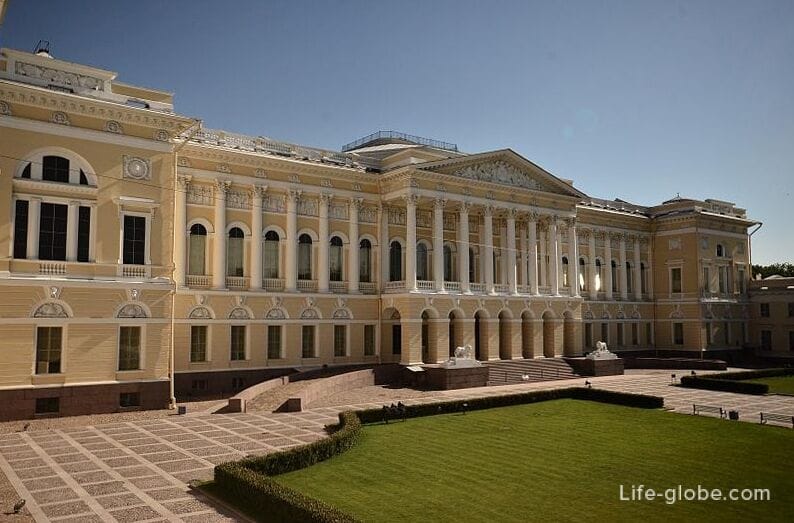
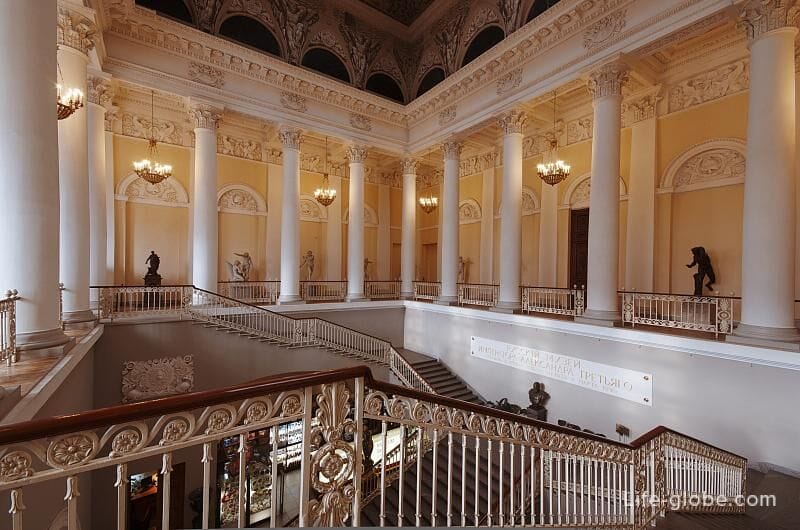
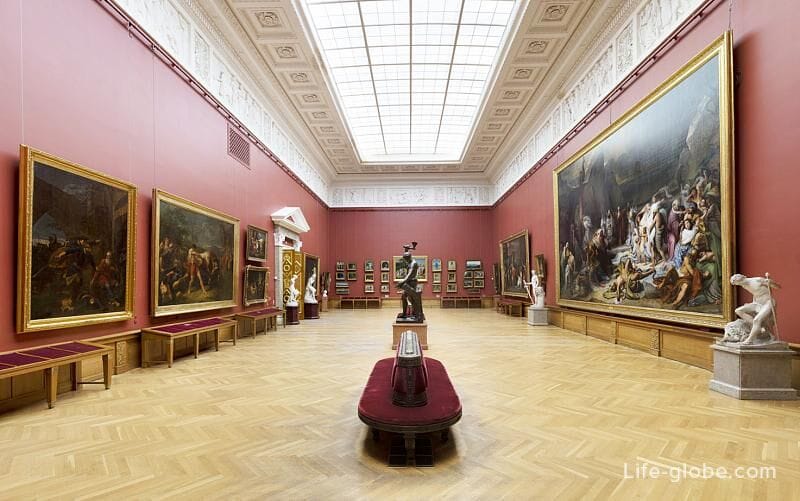
Next to the Mikhailovsky Palace, on the embankment of the Griboyedov Canal 2, there is a building-the Benoisbuilding, which is connected to the wing of the Mikhailovsky Palace by a special passage.
The Benoit Building was built in the early 1900s and was intended for exhibitions of various art associations and unions. Today the building belongs to the Russian Museum.
The Benoit building houses permanent art displays from the late 19th and early 21st centuries, as well as rooms for temporary exhibitions. Learn more about the Benoit Corps…
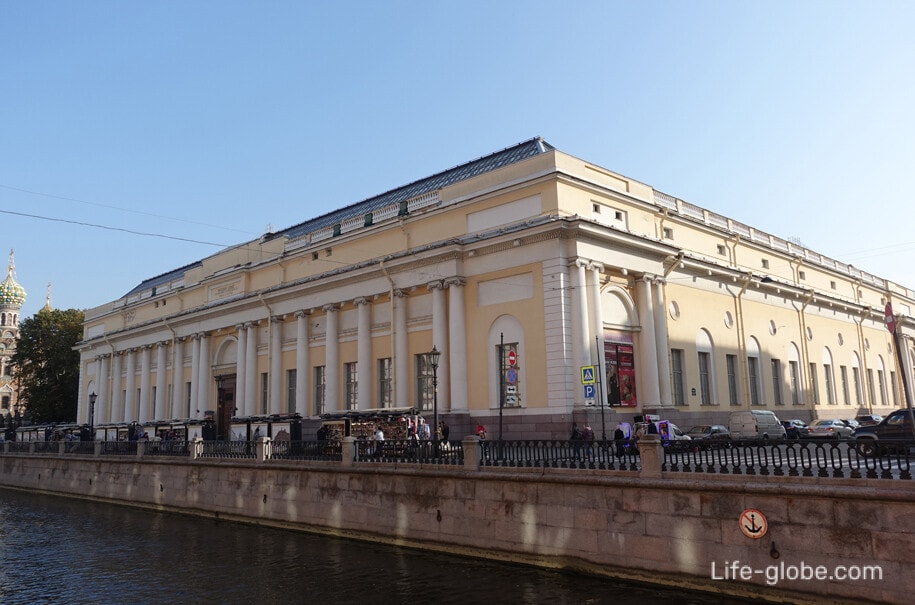
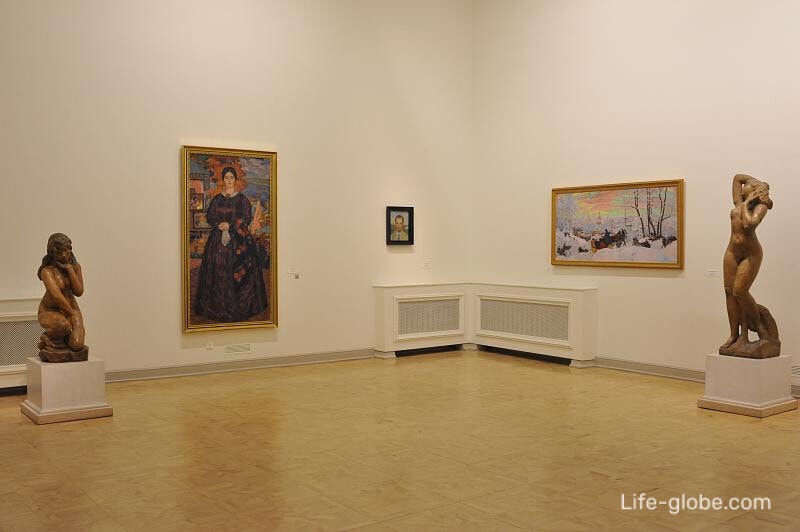

Mikhailovsky Castle (or Engineering Castle) - the former imperial Palace, is the largest architectural monument that completes the history of St. Petersburg architecture of the 18th century.
The castle is the only palace structure in Russia in the style of romantic classicism. In addition, the castle combines the features of a medieval knight's castle and a secular European palace.
The castle was built by order of Emperor Paul I in 1797-1801 on the site of the Summer Palace of Empress Elizabeth Petrovna, designed by architects V. I. Bazhenov and V. Brenn.
The name" castle "was promoted by the desire of Paul I, who took the title of Grand Master of the Order of Malta, to call all his palaces "castles".
The center of the castle complex forms an octagonal front courtyard. The castle is home to the Church of St. Michael the Archangel.
In the walls of the Mikhailovsky Castle, you can see some restored rooms and halls of the imperial residence. The museum's collections are also on display, including a portrait gallery, works of Russian art from the first half of the 19th century, and sculpture from the late 19th and early 20th centuries.
The main exhibition of the museum in the Mikhailovsky Castle is dedicated to the royal family and the Romanov dynasty emperors.
Address of the Mikhailovsky Castle: Sadovaya Street, 2. Learn more about Mikhailovsky Castle…


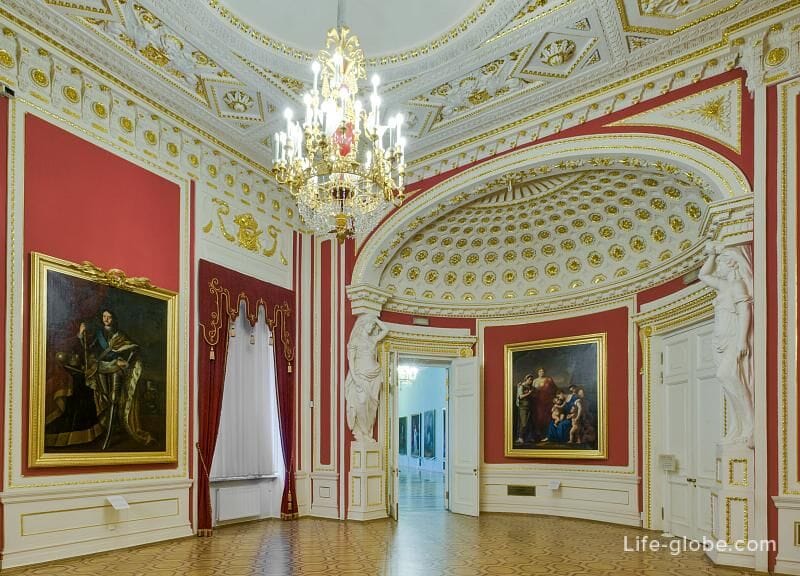
Near the castle, where Maple and Engineering Streets meet, there are two three-story buildings of the palace type-the pavilions of the Mikhailovsky Castle.
The construction of the pavilions was completed by 1800, and they served as the residence of the state ladies and ladies-in-waiting of the Highest Court.
In the Eastern Pavilion (Engineering Street, 10) there is a department of the museum - "Russian Center for Museum Pedagogy and Children's Creativity". In the West (Engineering Street, 8) - the Multimedia Center of the Russian Museum is located.
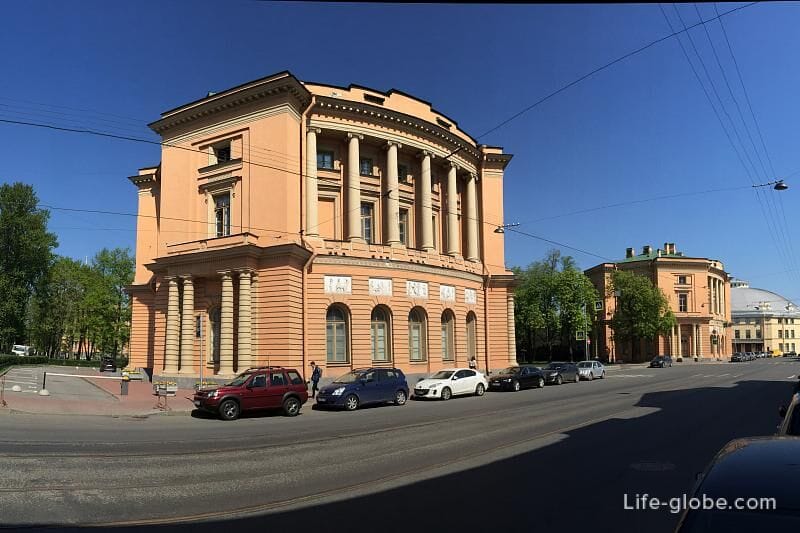
Stroganov Palace is one of the most impressive buildings in the center of St. Petersburg, as well as a monument of Baroque architecture.
The Stroganov Palace was formed in 1753-1754, when the architect of Italian origin Francesco Bartolomeo Rastrelli united the Stroganov houses into a single whole with a common facade belonging to the Baroque style.
in the late 18th and early 19th centuries, Andrey Voronikhin reconstructed and created a number of buildings and interiors of the palace in the classical style.
The palace exhibits the collections of the Russian Museum, including:
- Russian Empire. Decorative and applied art of the reign of Emperor Alexander I (1801-1825);
- Mineralogical cabinet;
- An art gallery, which represents a unique Russian interior of the turn of the 18th and 19th centuries. Numerous paintings, mostly by Western European masters, framed by a gilded baguette, occupy most of the plane of the gallery walls.
Also in the walls of the Stroganov Palace, you can see other restored rooms: the Great Hall or the Rastrelli Hall, the State Dining Room, living rooms and offices.
Address of the Stroganov Palace: Nevsky Prospekt, 17. Learn more about the Stroganov Palace…
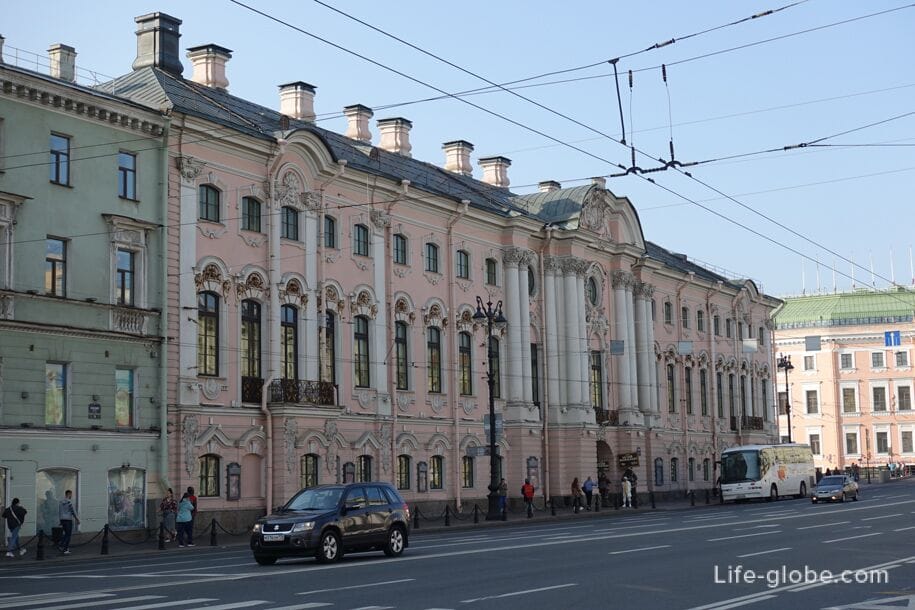

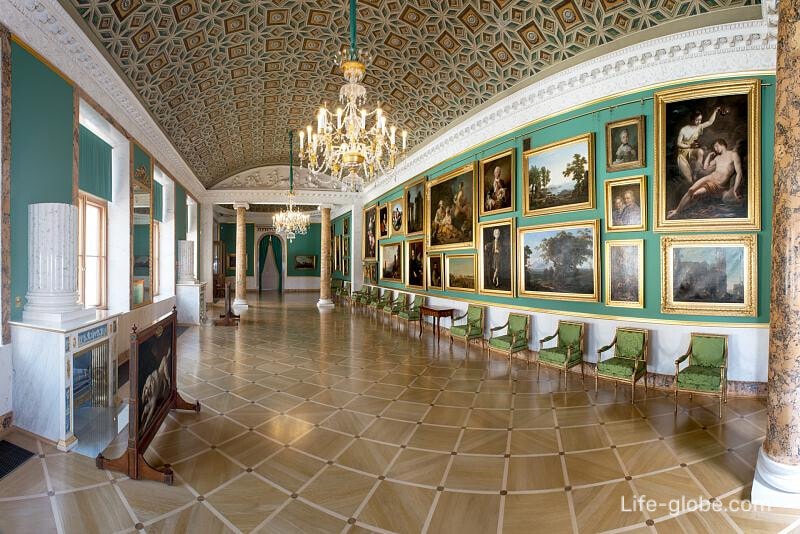
The Marble Palace is a monument of Russian architecture of the late 18th century.
The palace was the first building to be decorated with natural stone. The exterior facades of the palace represent the main artistic value - they have survived to this day, with only a few exceptions, in their original form.
The palace was built in 1768-1785 by the Italian architect Antonio Rinaldi, by order of the Empress Catherine II for the general-field-master Count Grigory Grigoryevich Orlov. But Orlov did not live to see the completion of the construction of the palace (he died in 1783) and Catherine II gave the palace to her second grandson - Grand Duke Konstantin Pavlovich in honor of his marriage in 1796.
One facade of the Marble Palace faces the Palace Embankment, the second - on Millionnaya Street.
The palace exhibits the collections of the Russian Museum, including:
Russian Russian Museum exhibition - the collection of German collectors Peter and Irene Ludwig, who donated their collection to the Russian Museum, which presents works by domestic and foreign artists of the second half of the 20th century. - The exhibition of the "Ludwig Museum in the Russian Museum" - the collection of German collectors Peter and Irene Ludwig, who donated their collection to the Russian Museum, which includes works by domestic and foreign artists of the second half of the 20th century.;
- memorial exhibition dedicated to the Grand Duke Konstantin Konstantinovich Romanov-the poet of the Silver age, who wrote under the kryptonym " KR»;
- a collection of works of art by St. Petersburg collectors - brothers Yakov Alexandrovich and Joseph Alexandrovich Rzhevsky.
Also in the walls of the Marble Palace you can see other restored rooms: the Grand Staircase, the Winter Garden, the halls, the Greek gallery and the interiors of the personal apartments of Grand Duke Konstantin Konstantinovich (study, music room, living rooms, library and reception room).
The address of the Marble Palace: 5/1 Millionnaya Street. Learn more about the Marble Palace…
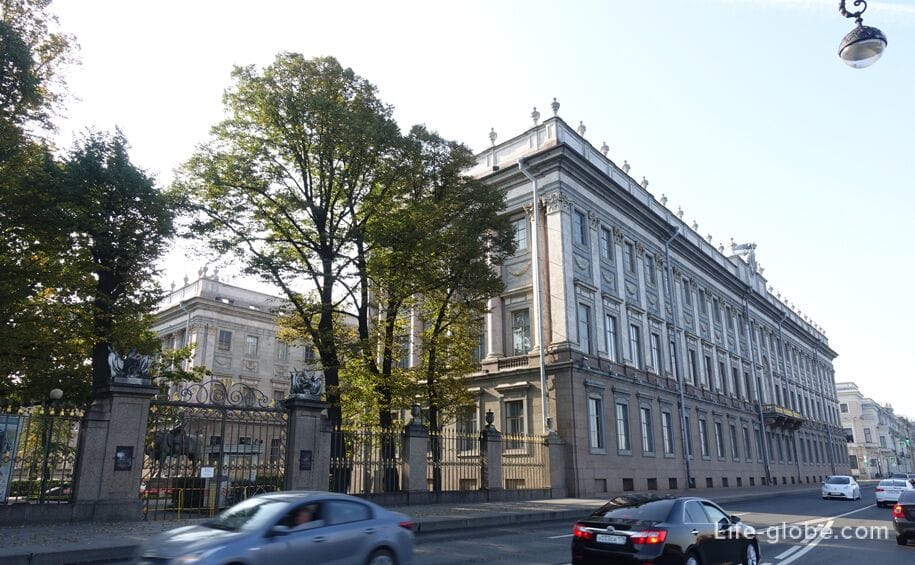
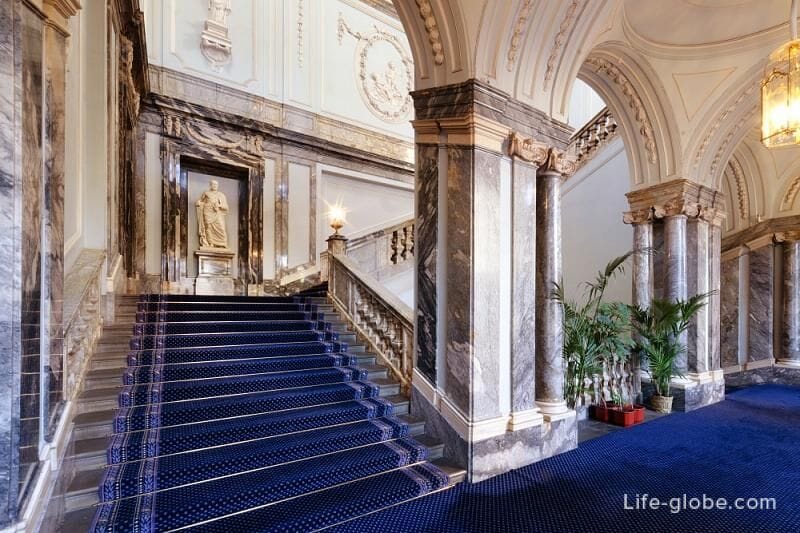

The Summer Palace of Peter the Great is the original residence of Peter the Great in St. Petersburg.
The palace was built in 1711-1712 in the Peter's Baroque style by the architect Domenico Trezzini.
Today it is one of the oldest significant buildings in the city.
The palace is quite modest for a royal residence, it has two floors and consists of several rooms and two kitchens.
The palace has restored the atmosphere of the royal dwelling of the early 18th century: allegorical plafonds in seven rooms of the palace, pine wardrobes, tiled stoves and wall decoration with painted Dutch tiles, wood paneling of the first floor rooms, interior decoration of the Lower and Upper Cookrooms and the Green Cabinet, where Peter's rarities are located.
The unique wind instrument (anemometer) in the Study of Peter the Great, which was commissioned by Peter the Great in Dresden and in 1714, stands out in the collection and still shows the direction and strength of the wind, as well as the time.
On the second floor of the palace is the Danzig wardrobe, in which, according to legend, Peter I kept his underwear and boots.
The museum in Peter's Summer courtyard is closed during the winter period, approximately from October to the end of April. For more information about the palace's operating hours, please visit the official website of the Russian Museum (the site is listed at the end of this article).
Address of the Summer Palace of Peter I: Summer Garden, letter A. Read more about the Summer Palace of Peter the Great..
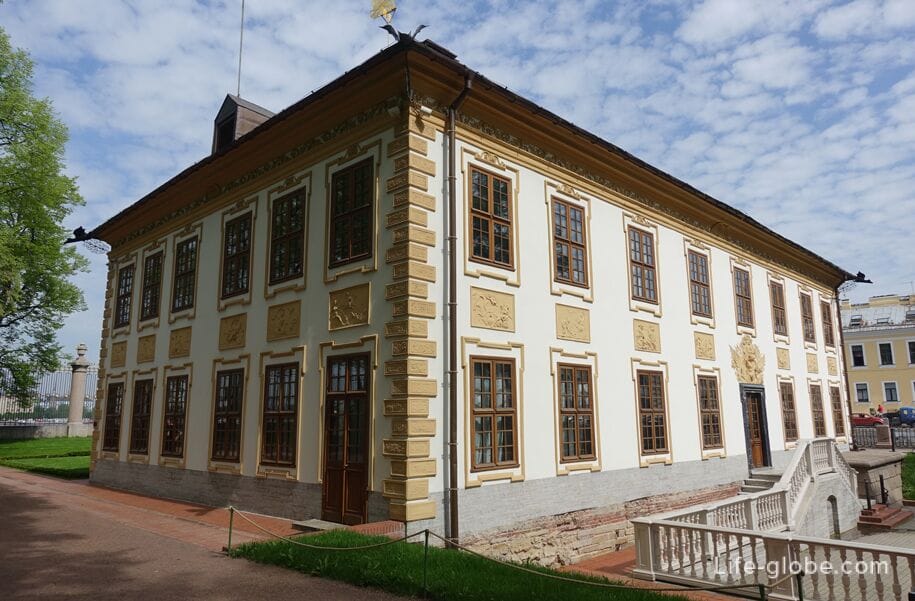
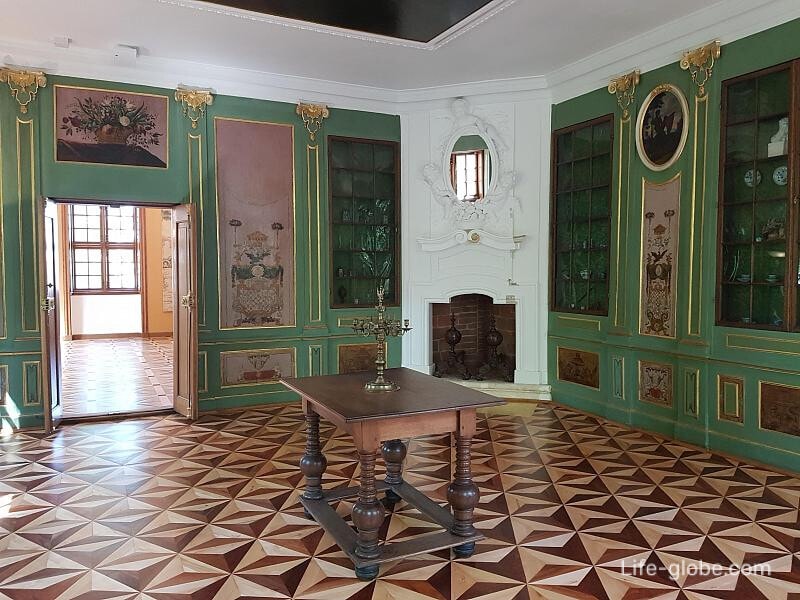
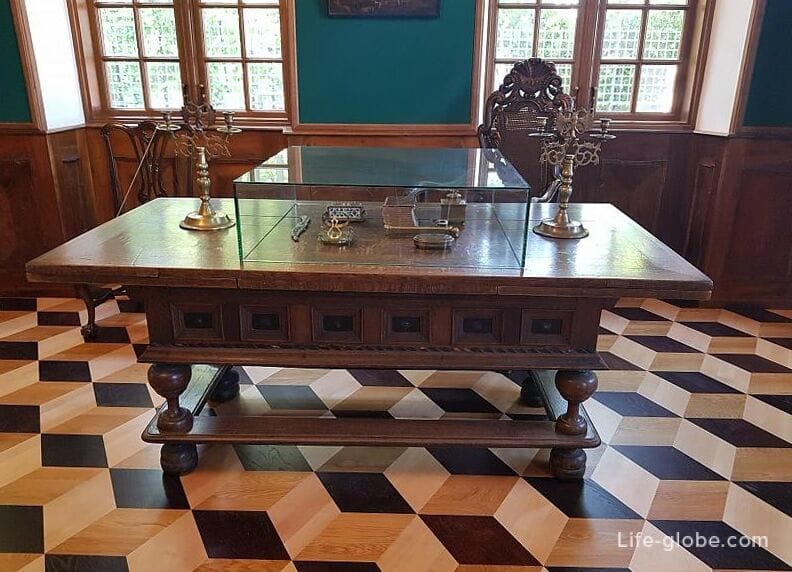
The House of Peter the Great is a unique architectural monument and the oldest building in St. Petersburg.
The wooden house was the first palace (summer residence) Peter the Great and in the documents of Peter the Great's time, it was called the " Original Palace "or"Red Mansions".
The house was built in May 1703. It consists of a 12,7×5,7 meters log house made of hewn pine logs.
The brick case of the House that exists today was built in 1844. In 1899, according to the project of the engineer-architect N. M. Salko, two vestibules were added to the case above the house of Peter I from the north and south. The northern vestibule was intended for the public, the southern one for storing the Peter I vereyka boat.
The exposition of the House of Peter I presents items related to Peter's time, including memorial ones: a red cloth uniform dress; an oriental cane; a cast of Peter's hand from an impression made at the Lipetsk iron foundry in 1707; a vereyka boat and a chair of Peter I.
The walls of the interior of the House, as in Peter's time, are covered with sea canvas. The windows are glazed with "moon" glass, made in our time according to the technology of the early 18th century. Also preserved is the painting on the door leaf from the dining room to the bedroom, which depicts the interior of a Western European cathedral.
Address of the House of Peter I: Petrovskaya embankment, 6 (Petrograd side).

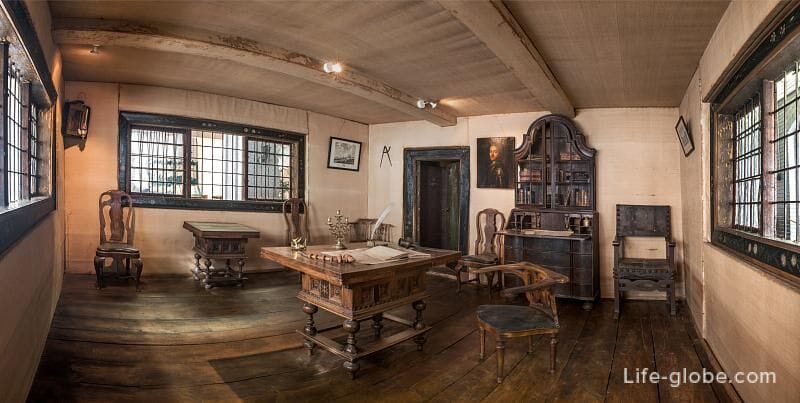
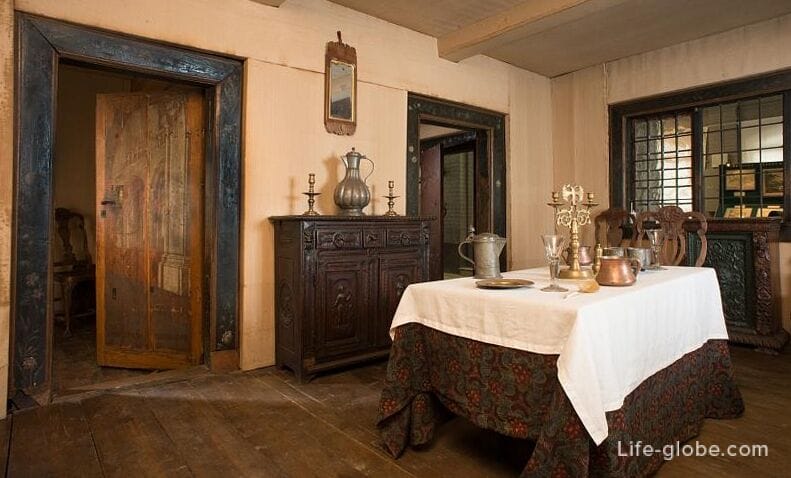
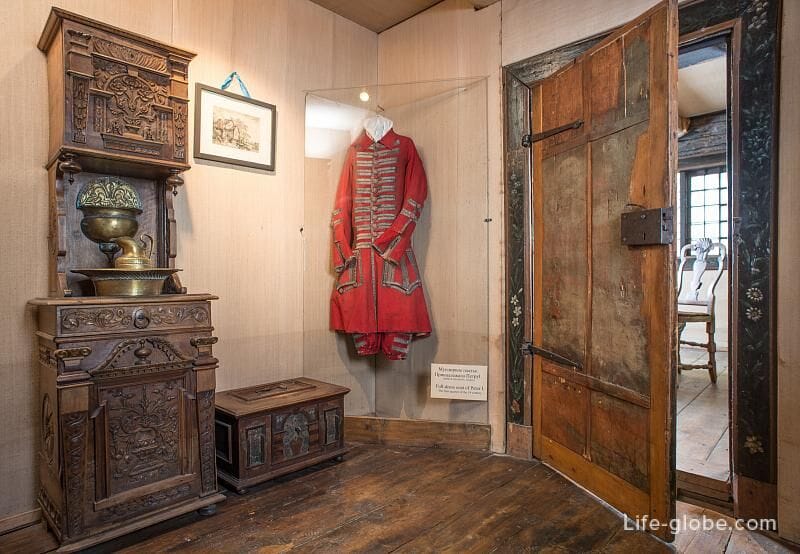
The museum complex also includes historical gardens: Mikhailovsky and Summer.
Mikhailovsky Garden is a well-maintained and one of the most famous gardens in the central part of St. Petersburg.
This garden is one of the rarest monuments of landscape architecture of the 18th-first third of the 19th centuries.
In the Mikhailovsky Garden there are: the Rossi circle, the Rossi pavilion and the Rossi bridge; a monument of wildlife of All-Russian significance - a petioled oak and a historical planting of the mid-18th century.
The northern facade of the Mikhailovsky Palace opens into the Mikhailovsky Garden.
The garden is located in the heart of St. Petersburg, near The Savior on Spilled Blood, between the Moika River, Griboyedov Canal, Engineering and Sadovaya Streets. Learn more about Mikhailovsky Garden...

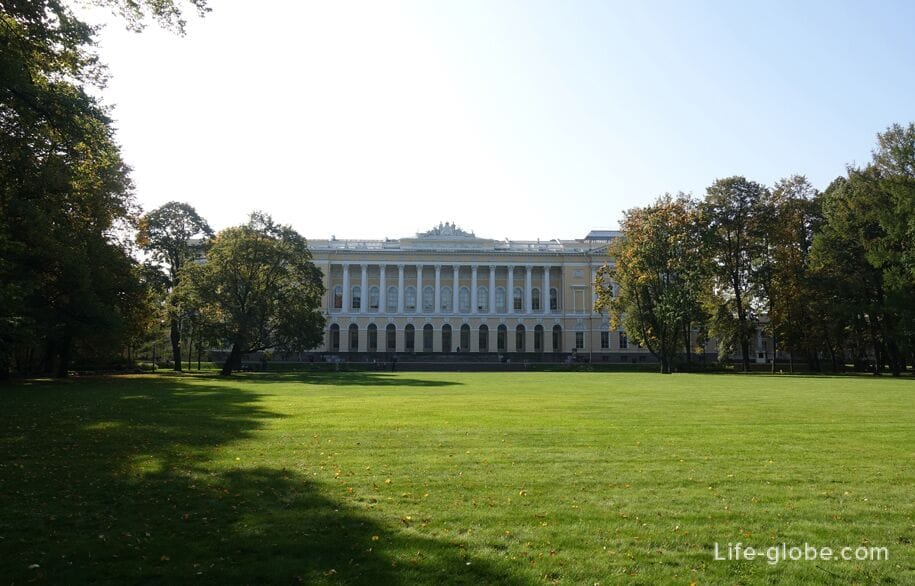
The Summer Garden was formed near the Summer Palace of Peter the Great.
The layout of the garden was formed by the 1710s.
Today, the Summer Garden is a park ensemble and is a monument of landscape art of the first third of the 18th century.
In the park there are: the Summer Palace of Peter I (now a museum; described above in this article), pavilions, alleys and paths for walking, cafes, places for recreation, a pond, a parterre, bosquets, borsos, fountains, sculptures, monuments and an exposition of the history of the Summer Garden..
Summer Garden is located in the center of St. Petersburg, close to Palace Square, between the Fontanka River, The Palace Embankment (Neva), the Lebyazhya Kanavka Canal and the Moika River. Learn more about the Summer Garden...
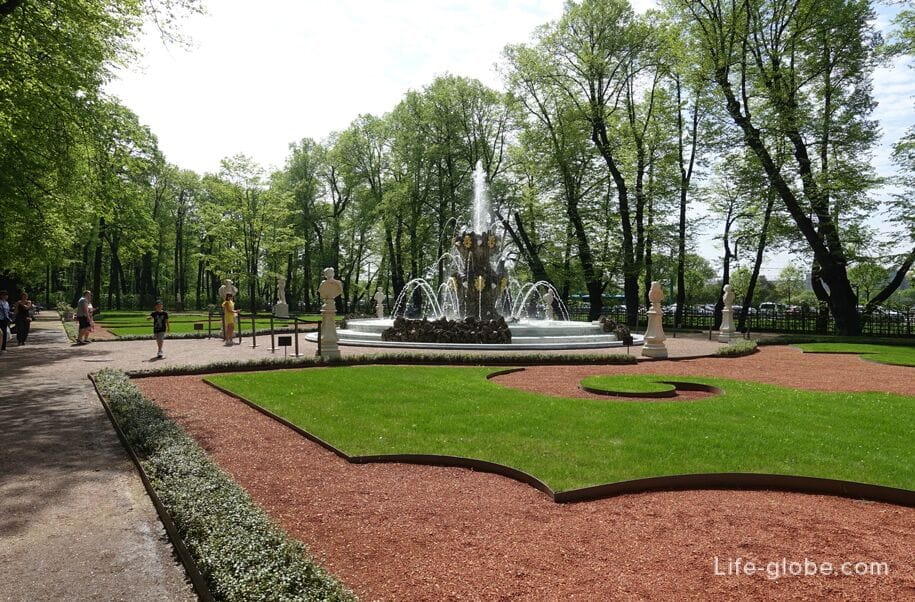
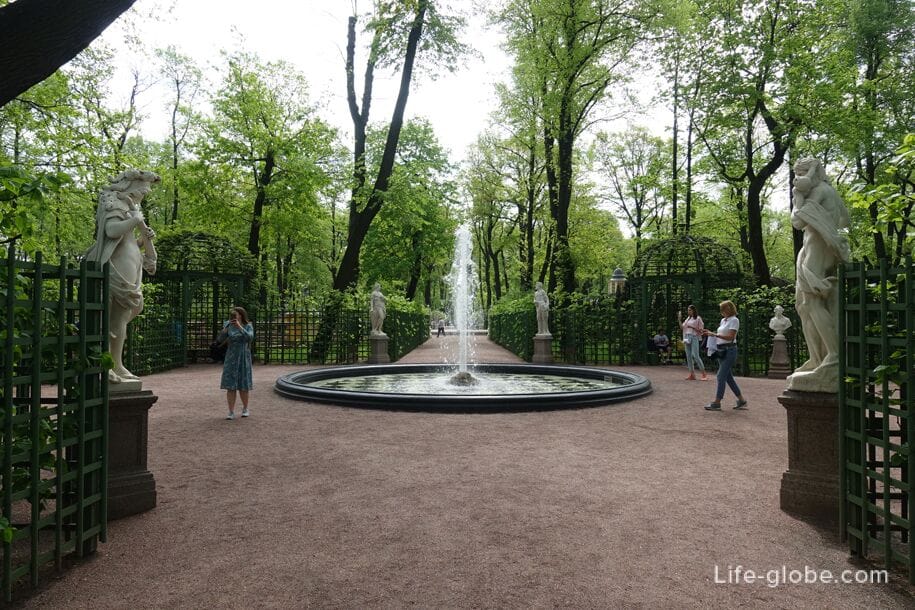
Entrance to the gardens is free (free of charge).
We recommend that you check the opening hours of the gardens directly before visiting the official website.
Website of the Russian Museum gardens: gardens-of-russian-museum.
The Russian Museum owns the Farm Pavilion in the village of Tyarlevo (near the city of Pavlovsk), located just over 30 kilometers from the center of St. Petersburg.
The pavilion was built at the request of the Empress Maria Feodorovna in 1802-1803 on the site of the dacha of Kantakuzen. Architect Andrey Voronikhin rebuilt the main building of the dacha as a pavilion, and also erected a number of outbuildings: a poultry house, stables, and a glacier. A pond was dug on the farm and trees were planted.
The pavilion building has two floors and consists of two volumes: an octagonal one and a quadrangular one attached to it.
The Russian Museum carried out a thorough restoration of the building and cleaned the pond.
Currently, there is no access for visitors to the territory of the "Farm" pavilion.
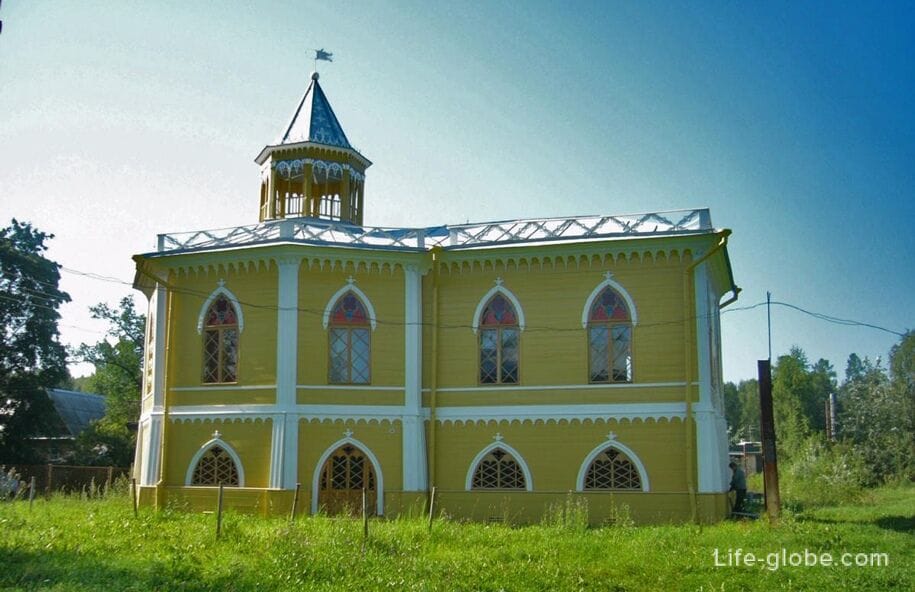
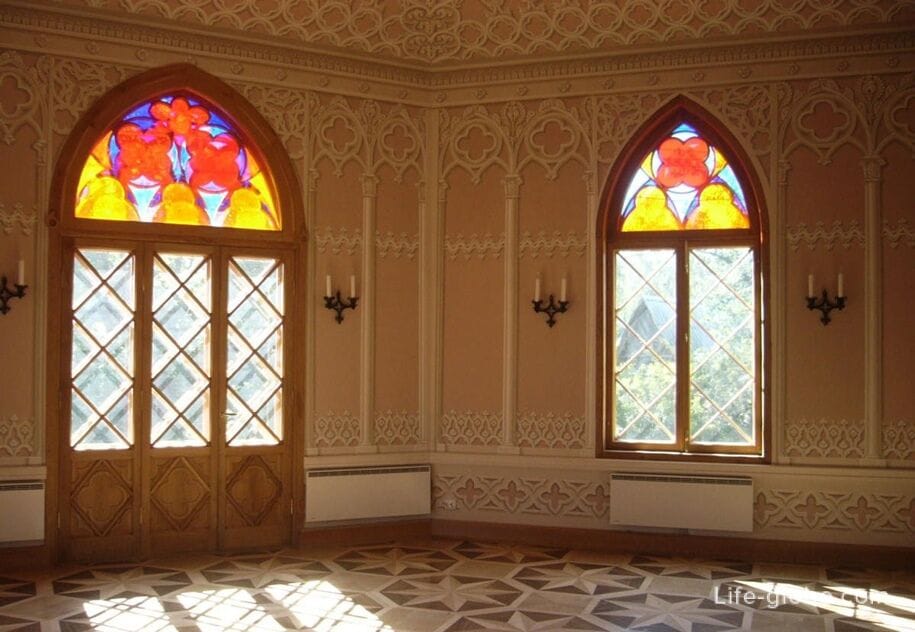
During the year, the Russian Museum organizes field exhibitions in Russian cities.
In Malaga (Spain) a branch of the Russian Museum has been opened, which hosts exhibitions and exhibitions based on Russian art.
Along with the exhibition space, the branch in Malaga includes: the information and educational center "Russian Museum: virtual branch", a children's educational center with creative workshops, cinemas, a gift shop and a cafe.
Branch address: Edificio de Tabacalera, Av de Sor Teresa Prat, 15.
Branch site: coleccionmuseoruso.
In addition to permanent exhibitions, the buildings of the Russian Museum also host temporary (rotating) exhibitions, events, lectures, classes and concerts.
At the information desks and ticket offices located in the museum buildings, you can learn about the museum's working hours, temporary exhibitions, events, lectures, classes and concerts held in the Russian Museum.
You can visit the branches (palaces) of the museum by purchasing individual tickets to the majority of each of the palaces or complex tickets to visit several or all of the objects of the Russian Museum.
All the necessary information, including about the museum's working hours, ticket prices, exhibitions and events held, exhibition plans, field exhibitions, representative offices, etc., we recommend that you check before visiting the official website of the museum.
Website of the State Russian Museum: en.rusmuseum.
All accommodation facilities in St. Petersburg, including in the city center and more remote from it, can be viewed and booked here